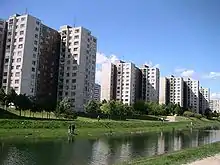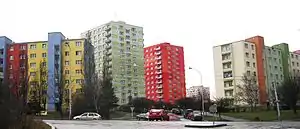Panelák
Panelák (Czech: [ˈpanɛlaːk]) is a colloquial term in Czech and Slovak for a panel building constructed of pre-fabricated, pre-stressed concrete, such as those extant in the former Czechoslovakia and elsewhere in the world. Paneláks are usually located in housing estates (Czech: sídliště, Slovak: sídlisko).

Panelák [plural: paneláky] is derived from the standard Czech: panelový dům or Slovak: panelový dom meaning, literally, "panel house / prefabricated-sections house". The term panelák is used mainly for the elongate blocks with more sections with separate entrances – simple panel tower blocks are called "věžový dům" (tower house) or colloquially "věžák". The buildings remain a towering, highly visible reminder of the communist era. The term panelák refers specifically to buildings in the former Czechoslovakia. However, similar buildings were built in other communist countries and even in the West.
History
Interwar Czechoslovakia saw many constructivist architects in the country, such as Vladimír Karfík and František Lydie Gahura, many of whom would maintain prominence following the establishment of the Czechoslovak People's Republic in 1948.[1] In the years following 1948, the Czechoslovakian architectural scene favored Stalinist architecture over more modern architecture.[1] However, a 1954 speech by Nikita Khruschev encouraging the construction of panel buildings, coupled by post-war housing shortages faced throughout both eastern and western Europe, encouraged the country's architectures to construct more simplistic, modernist buildings.[1] Planners from the communist era wanted to provide large quantities of fast and affordable housing and to slash costs by employing uniform designs over the whole country. They also sought to foster a "collectivistic nature" in the people. In case of war, these houses would not be as susceptible to firebombing as traditional, densely packed buildings. Throughout the mid 1950s, the country's designers applied a modernist aesthetic known as the Brussels Style, named after the international attention it attracted during the 1958 World’s Fair held in Brussels.[1] By the late 1960s, the country's paneláks often reached up to 16 stories in height.[1] The
Between 1959 and 1995, paneláks containing 1.17 million flats were built in what is now the Czech Republic. As of 2005, they housed about 3.5 million people, or about one-third of the country's population.[2]
In Prague and other large cities, most paneláks were built in a type of housing estate known as a sídliště. Such housing developments now dominate large parts of Prague, Bratislava and other towns. The first sídliště built in Prague was Petřiny in the 1950s; the largest in Prague is Jižní Město (about 100,000 inhabitants), with 200 buildings built since the 1970s.
Following the country's Velvet Revolution in 1989, there was widespread speculation that the country's paneláks would fall out of favor, due to their simplicity and small size.[1] The Czech government sold the paneláks to their tenants for cheap prices, furthering speculation that the apartments would be undesirable.[1] However, these fears have not materialized.[1]
Characteristics

In comparison to pre-war apartment buildings, paneláks can be truly enormous. Some are more than 100 metres long, and some are more than 20 stories high. Some even have openings for cars and pedestrians to pass through, lest they have to go all the way around the building.
A typical panelák apartment has a foyer, bathroom, kitchen, a living room also used for dining, and a bedroom.[1] All paneláks in the Czech Republic were constructed to follow one of sixteen design patterns.[2]
Paneláks have been criticized for their simplistic design, poor-quality building materials, and their tendency to become overcrowded.[1] In 1990, Václav Havel, who was then the president of Czechoslovakia, called paneláks "undignified rabbit pens, slated for liquidation".[2] Panelák housing estates as a whole are said to be mere bedroom communities with few conveniences and even less character.
However, paneláks have also been praised by many. Upon their introduction, paneláks offered more reliable heating, hot water, and plumbing than existing buildings, especially those in rural locations.[1] The buildings typically offered large amounts of natural light, compared to their older counterparts.[1]
Some housing estates do have other facilities, such as shopping centres, schools, libraries, swimming pools, cinemas and such. Also, architects sometimes made an effort to make the buildings distinct, by mixing various types of paneláks, for example, or by using different colours. Well-designed housing estates also have some environmental advantages. By leaving wide spaces between buildings, designers created large green spaces and parks, which are lacking in many prewar Czech neighbourhoods. In some places, paneláks were an improvement in sanitary conditions.
Paneláks today
Paneláks remain commonplace today, and have attracted a wide diversity of social classes.[1][2][3] Fears that paneláks would become undesirable and be subject to middle class flight, commonplace following the Velvet Revolution, have not materialized.[1] Nevertheless, concerns remain about the social situations of those living in panelák apartments, as well as their decay. However, the cost of replacing of paneláks in the short term would be well beyond the means of the Czech Republic or Slovakia. Panelák apartments have risen in value more than brick apartments, have been praised for housing people from a wide variety of incomes, and have been subject to a number of positive cultural depictions including magazines and TV shows.[1] Most Panelák apartments also are rent-controlled, and are therefore significantly cheaper than newer not rent-controlled flats.[2]
Areas with high shares of its population living in paneláks include the city of Karvina (where apprxomiately 97% of people live in them),[2] Petržalka,, and the city of Most (approx. 80%). Most's historical city was largely torn down due to the spread of coal mining and the majority of its population was moved into paneláks.
Amenities
Some Czech sociologists fear that panelák inhabitants may lack amenities, and suffer from being unable to physically access distant businesses and commercial centres. To combat this, certain local authorities are making significant efforts to prevent this scenario by changing bedroom communities into multifunctional urban neighbourhoods. This may include support for the construction of missing facilities, such as shopping centres, churches, or improved transport accessibility.
Paneláks, particularly in big cities, are often the first targets for builders of telecommunication networks, as the housing estates combine a high concentration of people with easy access to underground and in-house spaces for cables. Panelák housing estates are usually the first neighbourhoods with access to cable TV, WiFi network coverage, cable-modem service, DSL and other telecommunication services.
Renovations
In 2005, the director of the Czech Ministry of Regional Development expressed concerns that the country's paneláks were near the end of their lifespan, citing an increasing number of structural incidents.[2] He estimated that his agency would need 400 billion Czech koruna to modernize the country's paneláks, and 1.5 trillion to tear them down entirely.[2]
In recent years, many paneláks have been renovated, partially due to funds from the European Union.[1] A sizable renovation market has formed in recent years, and even a home magazine, Panel Plus, exists to give renovators ideas.[1]
Ownership
Following the Velvet Revolution, most paneláks were sold to their tenets at low costs.[1] Many panelák flats are now the property of their inhabitants, though they are also rented out through private landlords. The buildings are often managed by managed by housing cooperatives, municipalities, self-governing non-profit organizations, or through public-private partnership.
Other countries
Buildings similar to paneláks were built also in other communist countries, and they are a common feature of cityscapes across Central and Eastern Europe, and to some degree Northern Europe.
One of the most drastic reconstruction policies of the Eastern Bloc was the systematization programme that took place in the 1970s and 1980s under Nicolae Ceaușescu in Romania. In 1971 Ceaușescu visited North Korea and was impressed by the Juche ideology. He enacted a mass programme of demolition and reconstruction of existing villages, towns, and cities, in whole or in part, in order to build blocks of flats (blocuri).
In Bulgaria, buildings similar to paneláks are colloquially known as "panelki", and are the predominant type of en masse housing throughout the country. In Hungary, similar buildings are called panelház.[1] In Poland, they are called "bloki" (blocks), or "wielka płyta" (the great panel).[1] In Germany they are known as Plattenbau.[1] Most buildings in Soviet-era Microdistricts are panel buildings.
In the European Union, among former communist countries, a majority of the population lives in flats in Latvia (65.1%), Estonia (63.8%), Lithuania (58.4%), Czech Republic (52.8%) and Slovakia (50.3%) (as of 2014, data from Eurostat).[4] However, not all flat dwellers in Eastern Europe live in communist era blocks of flats; many live in buildings constructed after the fall of communism, and some in buildings surviving from the era before communism.
In the United States, some housing estates have buildings that are similar or actually are paneláks, or they are built from the same or similar material.
Popular culture
- The movie Panelstory from Vera Chytilova shows the life of several inhabitants in a real unfinished communist-bloc apartment project. Awarded a Great Prize in San Remo in 1980.
- Béla Tarr's film Panelkapcsolat tells a doomed love story set in a similar housing project in Hungary. Special Mention at the 1982 Locarno Film Festival.
- Polish director Krzysztof Kieślowski's celebrated Dekalog series is set in a wielka płyta housing estate in Warsaw, Poland.
See also
| Wikimedia Commons has media related to Plattenbau. |
- Sídlisko (Slovakia)
- Brutalist architecture
- Minimalism
- Million Programme (Sweden)
- Housing estate
- Public housing
- Affordable housing
- Subsidized housing
- Subsidized housing in the United States
- Section 8 (USA)
- Plattenbau (Germany)
- Panelház (Hungary)
- Khrushchyovka (Former Soviet Union)
References
- Bibliography
- Stankova, Jaroslava, et al. (1992) Prague: Eleven Centuries of Architecture. Prague: PAV. ISBN 80-900003-1-2.
- Zarecor, Kimberly Elman (2011) Manufacturing a Socialist Modernity: Housing in Czechoslovakia, 1945–1960. Pittsburgh: University of Pittsburgh Press. ISBN 0-8229-4404-9.
- Chánov case study
- Notes
- O'Sullivan, Feargus (2020-09-30). "Prague's Communist-Era Apartments Get a Second Life". Bloomberg CityLab. Bloomberg L.P. Archived from the original on 2020-10-04. Retrieved 2020-10-04.
- Reynolds, Matt (2005-03-10). "Still standing". The Prague Post. Archived from the original on 2005-03-12. Retrieved 2020-10-04.
- iHNed.cz. "Zachrante nase panelaky, tlaci na EU Cesko". ihned.cz/ (in Czech). Archived from the original on 2006-08-22. Retrieved 2020-05-16.
- see section Source data for tables and figures, Housing statistics: tables and figures






